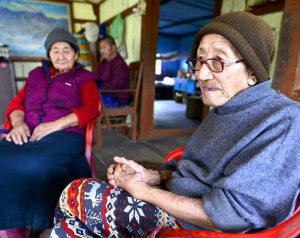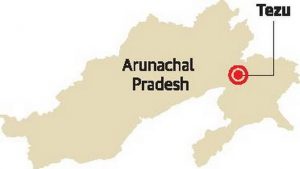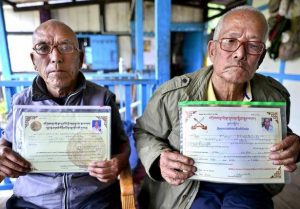http://www.thehindu.com /
Kallol Bhattacherjee / UPDATED: MARCH 11, 2017 05:23 IS
 In a camp in Tezu, Arunachal Pradesh, we meet the last of the Tibetan fighters living in exile. They battled the Chinese and later went on to fight for India in the war to liberate Bangladesh.
In a camp in Tezu, Arunachal Pradesh, we meet the last of the Tibetan fighters living in exile. They battled the Chinese and later went on to fight for India in the war to liberate Bangladesh.
On December 16, 1971, the India-Pakistan war ended with the liberation of Bangladesh. The war was short — it had raged for all of 13 days — but India had mobilised its entire land forces, including a secretive unit of soldiers from the Special Frontier Force (SFF), a group raised for trans-Himalayan combat. Some of the SFF recruits were not Indians. They were from Tibet and had come into India on forced exile, in waves and participated in the ground battles and the combing operations that followed with minimal knowledge of South Asian languages and the people they encountered. They had hoped that after the war India would send them home to fight the Chinese forces in Tibet as a reward — but that was not to be.
Dhondup Palden, now in his 80s, a resident of Lama Camp in Tezu, Arunachal Pradesh, was one of the Tibetans who despite their Buddhist faith took up arms. Sitting at the porch of his home-on-stilts that is painted blue and decorated with Buddhist prayer flags, he reminisces about the war and how he had ventured into unfamiliar territory. “We killed many enemies in that war. For 15 days, we moved across the country rounding up Pakistani soldiers and pro-Pakistan agents.” The war stood out as it was the first time that the Tibetans, a mountain people, had to negotiate with the riverine landscape of Bangladesh. “We walked on muddy riverbeds, and went from village to village looking for enemies. The experience was unusual for us Tibetan soldiers,” he says.

The war of 1971 was not the first Dhondup and his compatriots in Lama Camp experienced. Their war began 20 years earlier in the 1950s, when they fought a guerrilla battle against the Chinese forces in Tibet supported by weapons and trainers from the U.S. Central Intelligence Agency (CIA) which wanted to dislodge China from Tibet.
As we catch up with Dhondup, he is soaking in the celebrations of Losar, the Tibetan New Year which began in the last week of February. Losar to the Tibetans means crushed corn which is sprinkled on guests and meant for auspicious occasions, good food, drinks and a time to recollect the past. His kitchen is stocked with savouries and drinks. This is the Year of the Firebird which, like the phoenix, stands for resurrection and the burning away of wasteful deeds. Keeping with the spirit of the new year, Dhondup wants to relive the war of his youth.
“We had inadequate weapons and ammunition but we wanted to fight the Chinese who forced us to build roads and bridges,” he says in a mix of Hindi and Tibetan that was interpreted by his son Tsering. The guerrillas fought with .303 rifles of World War II vintage, receiving better weapons only in the later phase.
Dhondup and five other veterans are the remaining few from the hundreds of unknown foot soldiers of a liberation war, unlamented and unsung. These former soldiers were of fighting age; in exile now, time is ticking away. Many have passed away. One of their comrades, who rose to run a movie theatre in the neighbourhood, passed away earlier this year. They were the pioneers of a resistance movement that took to violence before the Dalai Lama weaned them away to non-violent means.
Enter the CIA
Dhondup was a member of the only modern insurgent group of Tibet, the Dhokham Chushi Gangdruk (DCG). The DCG was formed on June 16, 1958 in Tibet by a charismatic nobleman, Andrup Gonpo Tashi. For some time the group carried out ambushes against the Chinese forces as Beijing tried to consolidate its gains in Tibet. Dhondup, then in his twenties, was one of the early recruits in this movement and was trained in sabotage and the use of arms.
“During the struggle, we used basic weapons like the old rifles that fired one bullet at a time,” he says, explaining that the movement expanded rapidly from the Kham region of Tibet despite shortage of weapons and ammunition.
The DCG became known worldwide for being the secret force of the CIA, which sent trainers and equipment to Tibet to support the rebels. Dhondup recalls how the Americans sent high-flying cargo jets into the Tibetan airspace for his group that consisted of 600 volunteers.
One of the key assignments of the DCG was to guard the Dalai Lama as he planned to go into India. A little distance away from Dhondup’s Tezu home lives one of the former DCG fighters who accompanied the Dalai Lama during that momentous journey. “The journey of 1959 was arduous. Yaks and horses were used to cross the snowy mountain. We ensured safety for the Dalai Lama with one group travelling with him and another providing support at Lhasa,” says Zolpa Sibu, the ex-DCG fighter.
Sibu is nostalgic about his DCG days. “We did not have the best of weapons to fight. Many of our comrades died in bombing and counter-insurgency operations carried out by the Chinese forces,” he says, recounting that even the force’s founder was brought to India with injuries he sustained in a blast. He remembers how grim the situation in Tibet had become. “We were evicted from our homes. Families broke up — the Chinese employed women and men separately for forced labour projects that would go on for months. Social and religious gatherings became impossible as the police questioned all such gatherings.”
The DCG put up a strong resistance, but the end was inevitable. Sibu was arrested but released after months of detention. As was Dhondup. “I was kept in prison for two months and for weeks my hands were tied up,” he says, showing his permanently scarred hands.
The DCG’s fighters decided to escape into India through the mountain passes in eastern Arunachal district of Upper Dibang Valley and the western district of Tawang via Bomdila. The journey was difficult; many perished but the likes of Dhondup, Sibu and their families survived the trek.
The war for Bangladesh
Soon after coming into India, these fighters were asked to settle in Tezu but within a year they had to move as India-China hostilities intensified in the run-up to the 1962 war. As the border districts of the North East Frontier Agency, as Arunachal Pradesh was then known, were evacuated, the fighters were resettled in Dibrugarh and Guwahati in Assam. They returned to Tezu after the war ended, and soon found themselves recruited by Indian military officers who had by now realised their potential as trained guerrillas and intelligence-gatherers. “The military instructors tested our firing skills, asked us to take physical fitness tests. Most of us passed the test and joined the Indian military as we were eager to go back to Tibet and fight the Chinese forces again,” says Dhondup.
The fighters boarded a train at Guwahati and were taken to Chakrata in Uttarakhand (then in Uttar Pradesh) where a rigorous training programme began to equip them for special military operations. “We were trained to handle mortar fire, automatic weapons, rocket launchers. I was specially recruited into a team of paratroopers in the SFF,” says Dhondup, explaining that the Tibetans were expected to go back into their country for special operations. As first-generation exiles, the men did not always understand the detailed discussions held among Indian military officers, but carried out the assigned duties nevertheless.
Havildar Sangey was also among the ex-DCG SFF recruits. He counts himself as lucky, having been taken as part of a three-member group for a special training programme in Europe. “I even trained with some American officials abroad,” he says, reliving his days as a paratrooper.
The hostility between India and Pakistan gave the SFF fighters a new chance to test their fighting skills. “During the 1971 war, many of our friends died fighting,” says Dhondup, recounting that the war had left him injured and he was admitted in the Armed Forces Medical College, Pune. “Generals and [Prime Minister] Indira Gandhi came to see us in hospital. We got a transistor radio as reward,” he adds, his eyes lighting up as he recounts the heady days.
By the time the Bangladesh war ended, most of the soldiers had acquired family and had young kids at home. But newer assignments beckoned, including reconnaissance missions in Ladakh and in the high Himalayas. “We wanted to fight in Tibet because the SFF [training] taught us lot more than we knew in the DCG days, but that fight never came,” rues Sangey. “We had all the necessary advanced weapons. We would not have left Tibet if we had these weapons and training at that time.”
Renewed rumble in the east

The amphitheatre of much of the 1962 war, the epic face-offs of yesteryear still linger in the air of the Arunachal Himalayas, especially the mountains from Tezu to Anjaw district which were the scene of the bloodbath of Namti where an unknown number of Indian and Chinese soldiers died.
Having spent their youth in the midst of guerrilla warfare and tectonic political churn, the elderly denizens of Lama Camp find themselves still engulfed by geopolitics thanks to the evolving importance of the Eastern Himalayas. In recent years, the U.S. and India have begun to work on salvaging the remains of aviators who crashed in the mountains near Tezu during World War II. The discovery of a Chinese citizen in the region in 2010 stirred up matters between India and China. Guang Liang spent months in a prison in Arunachal Pradesh before the Chinese reportedly took him back. In addition, barely a dozen kilometres from the neighbourhood of these former guerrillas is the brand-new easternmost airport of India at Tezu which can also host heavy bombers and cargo carriers. Recent reports about an impending visit by the Dalai Lama to Arunachal Pradesh have again stirred up the pioneers of DCG.
While the region remains the locus of power games, the exploits of the octogenarians of Lama Camp slowly recedes into oblivion. In the sunset of their lives, they wish to bequeath their saga of resistance in Tibet to posterity. “Most of us did not get a chance to lead a normal life. We were deprived of the education that would have trained us to record and write our experience as soldiers,” says Sibu.
The legacy and the future
In recent years there have been some attempts to recognise their signal contribution. The Central Tibetan Administration has set up offices in Delhi and Dharamsala for addressing the needs of these senior community members. On the 50th anniversary of the founding of DCG in 2008, special commemorative events were organised by the Tibetan community in India to honour them and recognise the armed struggle that they executed against China.
Young Tibetans also drop in once in a while to seek blessing of these elders. The Tibetan diaspora has also shown interest in chronicling the story of DCG and a number of websites provide information about the violent movement which faded out with the exile of Tibetans to India. However most of the literature focusses on the CIA’s role in fuelling the war in the Cold War period and is inadequate in recording the narratives of the men who fought the war not just for the CIA but also for India. “Our lives were disrupted. At the time of DCG, we did not foresee our exile and that is why we did not bother to photograph our homes and our struggles,” says Sibu, urging better documentation of the scattered photographs and other records of the movement in Tibet.
Despite their advancing years, the DCG fighters do not receive any additional financial support from the Government of India — the SFF gave a comprehensive settlement package, a one-time lump-sum amount at the time of retirement.
While the passage of time has dimmed Dhondup, Sibu and Sangay’s hopes of returning to their homeland, the fire still burns. “Even now I dream of fighting in the streets of Tibet with a gun,” says Dhondup. The DCG, incidentally, still exists in exile, espousing an independent Tibet. Dreams don’t die.




 Print
Print Email
Email